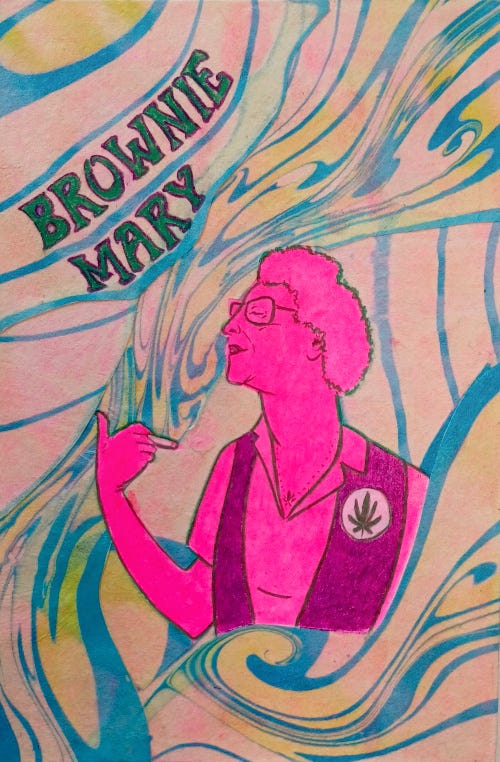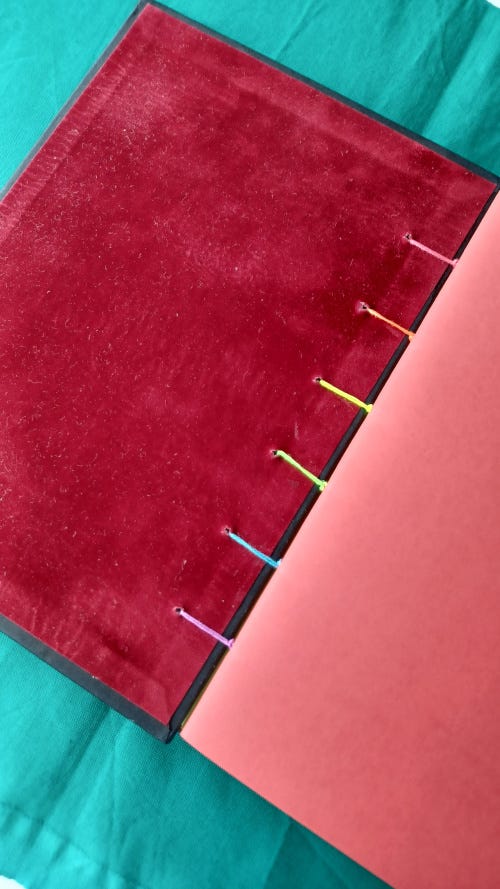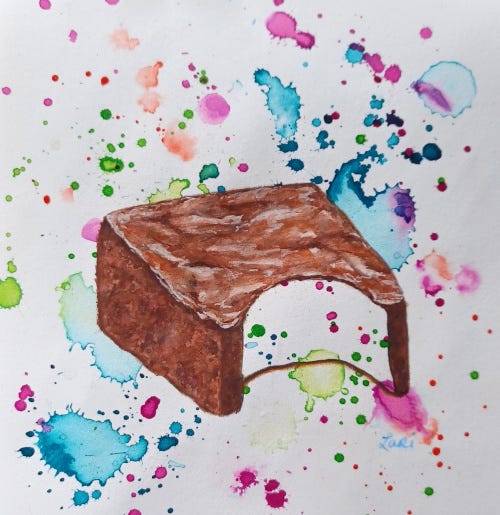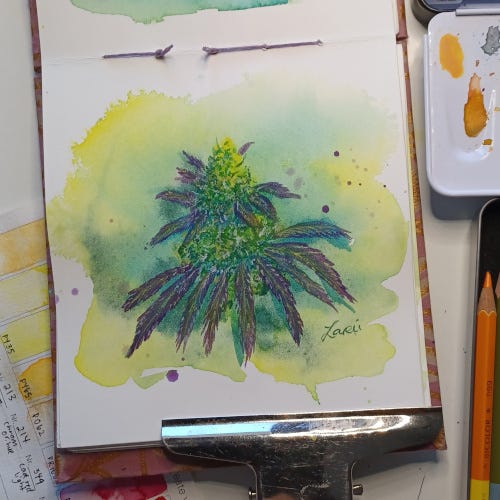Welcome back to RENDERED! This is my second profile of a notable woman in culinary history; my first piece was on Eugénie Brazier, aka. Mother Brazier. That episode of TIDBITS is available for paid subscribers here.
Mary Jane “Brownie Mary” Rathbun was an activist and self-identified anarchist who pioneered the therapeutic use of cannabis for those suffering the effects of HIV/AIDS in San Francisco in the 1980’s and 1990’s. This month, I’m talking about the legacy of Brownie Mary, one badass little ol’ lady who was eulogized as “the Florence Nightingale of the medical marijuana movement.”

First: A Brief History of Cannabis Edibles
Native to Central Asia, Cannabis sativa has been used by humans for at least 4500 years: as food, for its fiber, and for its medicinal qualities. From the Himalayan region, it spread to Persia, Southern Siberia, and China.
Cannabis use in the ancient world was well documented in writing. Ancient Greek writer Herodotus wrote of a Scythian funeral practice (5th century BC, on the Eurasian steppe). Tents were constructed and pits dug within, filled with red-hot stones upon which hemp seeds were scattered. The resulting vapor was ingested by the mourners to induce a euphoric feeling.
Cannabis indica is the more potent strain of cannabis; it was used in medieval Islamic medicine, and is capable of producing hashish (concentrated cannabis resin). It was likely brought to the Muslim world via trade to Persia from Central Asia, and was already known and documented back in the 12th century. One of my sources suggests that cannabis may have been brought to Egypt as early as the Arab conquest in the 7th century, traveling to the African continent from the Indian subcontinent by way of Arabia.
Majoun is the oldest known marijuana edible. This cannabis confection of hashish, spices, fruit and nuts has its origins in the Islamic world. In India, cannabis consumption dates back at least to 1000 CE. Bhang is a drink infused with cannabis, especially associated with the Hindu god Shiva.
In 1798, Napoleon and his troops invaded Egypt, where the French encountered hashish for the first time. It wasn’t long before hashish use was prohibited among French soldiers. A few 19th-century European physicians in Egypt and South Asia (brought there on colonial missions) created cannabis-infused tinctures and studied potential medical treatments using this strange, unknown plant. Europeans brought the hemp plant to the Americas during the age of colonization, where it continued to spread.
A recipe for marijuana edibles, “Hashish fudge (which anyone could whip up on a rainy day)” was famously included in Alice B. Toklas’s memoir/cookbook in 1954. The “fudge” recipe was contributed by a Morocco-based friend of hers, Brion Gysin (of the Beat Generation).
In fact, this recipe is a version of majoun. The fudge was a hit among US-American hippies in the 1960’s, attaining cult status–it’s now considered the precursor to the pot brownie.
Mary Jane Rathbun was born in 1922 and raised in a Chicago blue-collar neighborhood. Her social activism started as a teenager, when she advocated for abortion rights, and unionizing for miners. During World War II, she moved to San Francisco, was married briefly, and had a daughter named Peggy.
In the early 1970’s, Peggy tragically passed away in a car accident. During the years following the loss of her daughter, Mary found herself merging into the nightlife of San Francisco. She befriended many young gay men who were flocking to the city at the time, integrating into the vibrant gay scene. In 1974, she met her longtime friend and comrade, Dennis Peron, who would become known as “the Father of Medical Cannabis.” While working her day job serving pancakes at IHOP, she took on a little side gig: slinging her homemade pot brownies around the neighborhood for a few bucks a pop.
At first, it was all fun and games. It was during this time that she gained the nickname “Brownie Mary.” But she got arrested for the first time in 1981, and the cops confiscated 54 dozen brownies, plus 18 pounds of weed from her kitchen (for those unfamiliar, that is an astronomical amount of pot). Her second brush with the law came the following year, when a judge told her to cut the “Brownie Mary schtick.”
She took her brownie business underground, and opted to perform community service in lieu of doing jail time. She volunteered with the Shanti Project, a nonprofit organization, and every Thursday she was in the Ward 86 of San Francisco General Hospital, the country’s first AIDS clinic. Mary ended up volunteering there for over 10 years, far beyond the requirements of her legal obligation.
Mary came to “adopt” many of those youngsters as her own: they were all her kids. When the AIDS crisis hit, she was on the front lines, watching those vibrant kids start to wither away and lose their lives to a terrifyingly devastating disease.
She took her brownie operation into overdrive: she started making even more brownies, and distributed them to her kids. Those pot brownies induced the munchies to keep up their appetite and stave off the wasting disease, brought physical comfort that temporarily abated their pain, and also eased nausea in chemotherapy patients. Despite arthritis pain, 2 bum knees, and a bout with colon cancer, nothing could keep Mary from making brownies.
Her third arrest in 1992 brought her wider notoriety. She was busted with 2.5 pounds of weed, while she was in the middle of baking a fresh batch. Facing two felony counts of cannabis possession, her story ended up making international news. That lil’ ol’ lady cut a unique figure in the pro-cannabis movement; imagine a cute grandmotherly type on television, talking openly about AIDS and cannabis, for the sake of her kids. Who could argue with her? She was eventually acquitted of her charges.
Alongside her comrades, she helped establish the first cannabis buyer’s club in San Francisco in 1993; they openly sold weed in an effort to get caught, in order to set a legal precedent. That was the first cannabis dispensary in the country.
That same year, she and Dennis Peron released a self-published pamphlet, “Brownie Mary’s Marijuana Cookbook and Dennis Peron’s Recipe for Social Change.” Her famous recipe sadly wasn’t included, but a friend of hers did clue us in to one of her secrets: extra oil.
Mary Rathbun passed away in 1999 from a heart attack, aged 76.
“I’ll go to jail for my cause, you’re damn right I will. I’ll go to jail for my cause in a hot second.”
“If [the cops] wanna bust me, come up here and bust me now, because in two weeks I am gonna make 60 more dozen. And I’m gonna take them around San Francisco and deliver them all to my kids.”
Mary Rathbun’s story sits at the intersection of two histories: those of cannabis and of gay rights in the United States. Both are marked by stigma, discrimination, and government manipulation of public opinion.
First, let’s talk about weed. Cannabis. Mary Jane. Ganja. Reefer. Dope. Grass. Pot. Sticky Icky. I could go on. The name “marijuana” is now considered antiquated; it was used in the US from the early 20th century as a way to emphasize its “foreignness,” and play into xenophobic sentiment. Weed use was stereotypically associated with minorities like Mexicans, Filipinos, African Americans, and worst of all… jazz musicians! (“Scary, scary minorities smoke pot! They’re corrupting our wholesome American society!”) “Locoweed” was a drug for degenerates, lowlifes, social deviants and criminals. It made people delusional, psychotic, even violent. Propaganda proliferated, including the cult film Reefer Madness, released in 1936. Fearmongering based on economic and racial prejudice influenced federal law, and cannabis was federally prohibited in 1937.
So, it went underground. By the 1960’s, once young people had figured out that the anti-cannabis propaganda was complete bullshit, the countercultural movement fully embraced weed.
In a similar fashion to cannabis, homosexuality was also treated as a scourge to society. Anti-sodomy laws existed in the US for well over 100 years, starting from the 19th century until the 2003 Supreme Court case Lawrence v. Texas. Protecting “public morals and decency” in the 19th century devolved into full-on criminalizing homosexual activity in the 20th century. In the 1950’s, along with the Cold War came McCarthyism (aka. the demonization and political repression of leftists in the name of fighting communism).
The federal government secretly investigated its officials and, citing a Senate report that declared homosexuality to be a mental illness, purged thousands of military personnel and government employees for being gay. This is now known as the “Lavender Scare.” In 1953, President Eisenhower banned homosexuals from federal government jobs, as they were considered security risks.
During this time, right through the 1970’s, police across the United States were raiding gay bars, assaulting and arresting anyone engaging in homosexual activity and/or “crossdressing.” LGBTQ+ communities saw police brutality up close and personal, for the crime of nonconformity. Key incidents included the Cooper’s Do-nuts Riot (Los Angeles, 1959) and the Stonewall uprising (New York, 1969).
The San Francisco of Mary Rathbun’s day was marked by the 60’s counterculture movement, the Civil Rights Era, the gay rights movement, and the assassination of Harvey Milk in 1978.
Etymology note: The word “assassin” comes from Arabic for “hashish eater.” It was a derogatory reference to erratic and violent behavior, as if intoxicated from hashish.




LGBTQ+ people weren’t the only ones who had to be wary of the cops. Racial minorities like Latinos and Black Americans were also targeted.
President Richard Nixon initiated the War on Drugs in 1971, to combat “public enemy number one.” One of Nixon’s advisers later admitted that the anti-drug initiative was a roundabout way of targeting his political enemies: antiwar hippies and Black Americans. Cracking down on drugs gave a tangible reason to target *certain* populations for police harassment.
From 1981, with President Ronald Reagan, the War on Drugs was accelerated. The United States government spent nearly 2 billion dollars on increased policing and incarceration, enforcing harsher sentences for drug-related offenses, and funding efforts to scare youngsters out of using drugs. Not only did US-American prison populations swell to become the most bloated in the world, but racial profiling in policing meant that the people getting busted for drugs were disproportionately minorities.
“[Tell] all your friends, all your relatives, all your grandmas and grandpas. Tell ‘em that this war on marijuana is BULLSHIT!”
At the same time that politicians and lawmakers were unable to acknowledge the palliative effects of cannabis, they were also silent on HIV/AIDS.
1981 marked the first report of a “rare form of pneumonia in young gay men” from the US Centers for Disease Control and Prevention. First called GRID (Gay-Related Immune Deficiency), this mysterious “cancer” came to be colloquially known as the “gay plague” or “gay syndrome.” It was briefly called the 4H Disease (because it affected homosexuals, heroin addicts, hemophiliacs, and Haitians) before becoming AIDS in 1982.
An HIV/AIDS diagnosis was a death sentence back then, and nobody knew how it was transmitted. People were afraid to touch, hug, or even be in the same room as someone that was HIV-positive. Mainstream press helped stigmatize HIV, often blaming victims for contracting the virus. The most vulnerable people were painted with the additional social stigma of homosexuality, sex work, and drug use.
Even medical professionals avoided HIV/AIDS patients. In the 1980’s, so many US-American healthcare workers refused to treat those patients that Filipino healthcare workers were recruited en masse to address the gap. The United States colonized the Philippines (in 1898, under the same treaty that ceded Puerto Rico to the US), and has relied on Filipinos ever since to address gaps in the healthcare system ever since–especially during times of crisis like the COVID pandemic.
In 1991, Princess Diana’s now-famous handshake with an HIV-positive patient proved to the public that the virus could not be transmitted by touch. That same year, basketball superstar Magic Johnson announced he was HIV-positive, which destroyed stereotypes about HIV and forced the public to take it more seriously.
In short, nobody in power cared about AIDS when it was “only” affecting people considered undesirable, disposable. It’s easy to look back and wonder how people could be so ignorant. You’d think people would learn their lesson and do better. How could people just stand by and let it happen? How, indeed?
Brownie Mary’s advocacy helped support several groundbreaking pieces of legislation: Proposition P (the San Francisco medical marijuana initiative) in 1991, and Proposition 215 (the Compassionate Use Act of 1996). This made California the first US state to legalize the medical use of cannabis.
Since then, 37 more states and Washington, DC have followed suit. However, the subject remains controversial: cannabis remains illegal on the federal level, and there are still people in prison facing harsh legal repercussions for possession of cannabis.
“By sticking together, by putting resolutions before the city councils, by changing the politics of marijuana, [we can get the] medicine that helps my kids, or your kids, or any of our kids, feel better and live longer. I’m gonna continue to do this ‘til the day I die, you can bet your sweet ass on that. And the federal government can be damned!”
Brownie Mary was willing to risk getting busted by the cops because she found her cause just and correct: grief did not harden her spirit, but galvanized her into radical civil disobedience, all for the sake of her kids.
Any decent parent can identify with the feeling that you’d do anything for your children. To ease their suffering, to take away their pain, to honor them, and to mourn them when they pass on.
Even if it meant risking jail time, she was willing to do what was in her power to care for her kids, in the best way she knew how. Brownie Mary’s legacy is that of radical compassion, spitting in the face of antiquated drug laws to offer some comfort to a generation that was dying from HIV/AIDS, whom mainstream society had turned its back on. Social stigma be damned–her kids needed her, and she stepped up for them.
Her obituaries mention no immediate survivors; but that doesn’t mean she didn’t have family. She may have lost her only biological child, but in the decades after that loss, she became a motherly figure to many who needed her.
Family is what you create. It is not solely a matter of blood. This is perhaps the most impactful thing I’ve learned from my queer family.
Let the corporate rainbows be put away until next June. In my world, Pride is all year round, baby. Even if you think that Pride has nothing to do with you, or LGBTQ+ issues don’t affect you–they do. Whether you are aware of it or not, at least one person you know and love is LGBTQ+. Queer history is all of our history.
Long live the legacy of Brownie Mary, and other titans of radical civil disobedience who give of themselves out of love for the community.
“Maybe I’ll be remembered as a fat, little ol’ lady that helped get rid of these stupid marijuana laws. That’d be nice.”
Mary Rathbun inspired the creation of a political party: the Brownie Mary Democrats of California advocate for safe, reliable cannabis accessibility and protections for medical patients, as well as a definitive end to the War on Drugs.
Wanna see archival footage of the lady herself, including her appearance on the Maury Povich Show? Watch it on Youtube here.
Thanks for reading. RENDERED is a one-woman production, and your support is appreciated! If you're hungry for more content in audio format, consider a paid subscription. ALL paid subscriptions (5€/month, 40€/year) are entitled to a copy of my zine, “The Best of RENDERED, Vol. 1” while supplies last. Hand-bound, printed locally here in Anjou, France on recycled paper. All paid subscribers also have access to TIDBITS narrated essays and a permanent discount in my web shop. Art Collector subscribers (65€/year) receive a custom piece of art in addition to the above perks.
I am available for commission: please inquire via my website. I also have a web shop, and you can follow me on Instagram.
Coming soon is the second RENDERED Art Medley, a roundup of food illustrations I do outside of this newsletter, plus news from the studio! This will be free for all subscribers. Until then, be well!
-Lari
Bibliography
“40 Years of HIV Discovery: The First Cases of a Mysterious Disease in the Early 1980s.” Institut Pasteur, 5 May 2023. https://www.pasteur.fr/en/research-journal/news/40-years-hiv-discovery-first-cases-mysterious-disease-early-1980s
“Assassin.” Merriam-Webster Dictionary. Updated 27 Jun 2024. https://www.merriam-webster.com/dictionary/assassin
“Assassin, N., Etymology.” Oxford English Dictionary, Oxford UP, September 2023, https://doi.org/10.1093/OED/8298865374.
Blood, Michael R. “Report: Pot arrests still fall heavily on Hispanics, Blacks.” Associated Press, 17 Jul 2020. https://apnews.com/article/02383a8dcf7fbbef3b876c20a587b709
Brennan, Matt. “‘Winning Time’ HBO: True Story of Magic Johnson HIV Diagnosis.” The Los Angeles Times, 1 May 2022.
“Brownie Mary.” Youtube, Uploaded by Ruby Dunes Video, 6 Jan 2020.
“Brownie Mary R.I.P. 1999 Channel 2 San Francisco.” Youtube, Uploaded by Moon Trent, 16 Nov 2013.
BRUNNER, THEODORE F. “MARIJUANA IN ANCIENT GREECE AND ROME? THE LITERARY EVIDENCE.” Bulletin of the History of Medicine, vol. 47, no. 4, 1973, pp. 344–55. JSTOR, http://www.jstor.org/stable/44451345. Accessed 27 June 2024.
Cachero, Paulina. “From AIDS to COVID-19, America’s Medical System Has a Long History of Relying on Filipino Nurses to Fight on the Frontlines.” Time Magazine, 30 May 2021. https://time.com/6051754/history-filipino-nurses-us/
Dholakia, Nazish. “Legalizing Marijuana Doesn’t Mean It’s Legal for Everyone.” Vera Institute of Justice, 20 Apr 2021. https://www.vera.org/news/legalizing-marijuana-doesnt-mean-its-legal-for-everyone
Eckhouse, MJ and Saxen MJ. “Police Brutality and Why it is an LGBT Issue.” Kent State University.
Eplett, Layla. “Go Ask Alice: The History of Toklas’ Legendary Hashish Fudge.” Scientific American, 20 April 2015. https://www.scientificamerican.com/blog/food-matters/go-ask-alice-the-history-of-toklas-8217-legendary-hashish-fudge/
Fortunata, Aelia, and Ysabel da Costa. "Cannabis Consumption in the SCA Period: Bhang." https://ysabelsnotebook.wordpress.com/wp-content/uploads/2023/11/bhang_10-2023.pdf
Fortunata, Aelia, and Ysabel da Costa. “Hashish in Medieval Muslim cultures.” Nov 2022.
Gaines, Lee V. and Nicole Cohen. “‘Just say no’ didn’t actually protect students from drugs. Here’s what could.” NPR, 19 Dec 2023. https://www.npr.org/2023/11/09/1211217460/fentanyl-drug-education-dare
Harer, W. Benson. “The Marijuana Myth in Ancient Egypt.” Journal of the American Research Center in Egypt, vol. 51, 2015, pp. 356–58. JSTOR, https://www.jstor.org/stable/26580648. Accessed 27 June 2024.
Hodge, Jamila. “Fifty Years Ago Today, President Nixon Declared the War on Drugs.” Vera Institute of Justice, 17 Jun 2021. https://www.vera.org/news/fifty-years-ago-today-president-nixon-declared-the-war-on-drugs
Jay, Mike. “Cannabis and Hashish in the West: The Colonial Origins.” Yale University Press, 20 Apr 2024. https://yalebooks.yale.edu/2024/04/20/cannabis-and-hashish-in-the-west-the-colonial-origins/
Kuddus, Mohammed & Ginawi, Ibrahim & Al-Hazimi, Awdah. (2013). Cannabis sativa: An ancient wild edible plant of India. Emirates Journal of Food and Agriculture. 25. 736-745. 10.9755/ejfa.v25i10.16400. https://www.researchgate.net/publication/260988477_Cannabis_sativa_An_ancient_wild_edible_plant_of_India
LoBianco, Tom. “Report: Aide says Nixon’s war on drugs targeted blacks, hippies.” CNN, 24 Mar 2016. https://edition.cnn.com/2016/03/23/politics/john-ehrlichman-richard-nixon-drug-war-blacks-hippie/index.html
M. D. Merlin. “Archaeological Evidence for the Tradition of Psychoactive Plant Use in the Old World.” Economic Botany, vol. 57, no. 3, 2003, pp. 295–323. JSTOR, http://www.jstor.org/stable/4256701. Accessed 27 June 2024.
Margolin, Madison. “Brownie Mary Is the Reason You Can Get Medical Marijuana Today.” Bon Appétit, 29 Apr 2019. https://www.bonappetit.com/story/brownie-mary
“Milestones in the American Gay Rights Movement.” American Experience, PBS. https://www.pbs.org/wgbh/americanexperience/features/stonewall-milestones-american-gay-rights-movement/
Miller, Zeke. “Biden pardons thousands convicted of marijuana charges on federal lands and in Washington.” Associated Press, 22 Dec 2023. https://apnews.com/article/biden-marijuana-pardons-clemency-02abde991a05ff7dfa29bfc3c74e9d64
Popova, Maria. “The Alice B. Toklas Cookbook, Illustrated.” The Marginalian, 4 Mar 2013. https://www.themarginalian.org/2013/03/04/the-alice-b-toklas-cookbook-folio-natacha-ledwidge/
Saxon, Wolfgang. “Mary Jane Rathbun, 77, Baker Known for Marijuana Brownies.” The New York Times, 14 Apr 1999. https://www.nytimes.com/1999/04/14/us/mary-jane-rathbun-77-baker-known-for-marijuana-brownies.html
Stanley, Eric. “Collections Spotlight: Brownie Mary’s Marijuana Cookbook and Dennis Peron’s Recipe for Social Change.” Museum of Sonoma County, 22 Jun 2021. https://museumsc.org/collections-spotlight-brownie-marys-marijuana-cookbook/
Tikkanen, Amy. "Why Is Marijuana Illegal in the U.S.?". Encyclopedia Britannica, 15 Apr. 2019, https://www.britannica.com/story/why-is-marijuana-illegal-in-the-us. Accessed 27 June 2024.
“Trailer of California Chronicles Of Medical Marijuana.” Youtube, Uploaded by claireburch, 6 Aug 2007.
“War on Drugs.” Encyclopedia Britannica, 27 May 2024. https://www.britannica.com/topic/war-on-drugs
Weinmeyer, Richard. “The Decriminalization of Sodomy in the United States.” AMA Journal of Ethics, Nov 2014. https://journalofethics.ama-assn.org/article/decriminalization-sodomy-united-states/2014-11
Woo, Elaine. “‘Brownie Mary’ Rathbun Dies; Advocated Medical Marijuana.” The Los Angeles Times, 13 Apr 1999. https://www.latimes.com/archives/la-xpm-1999-apr-13-mn-26991-story.html





As always, so informative. This was a hellish time in history not knowing how aids was transmitted and so many innocents afflicted. Cannabis and its connection to brownies and a little old lady trying to bring comfort. ❤️